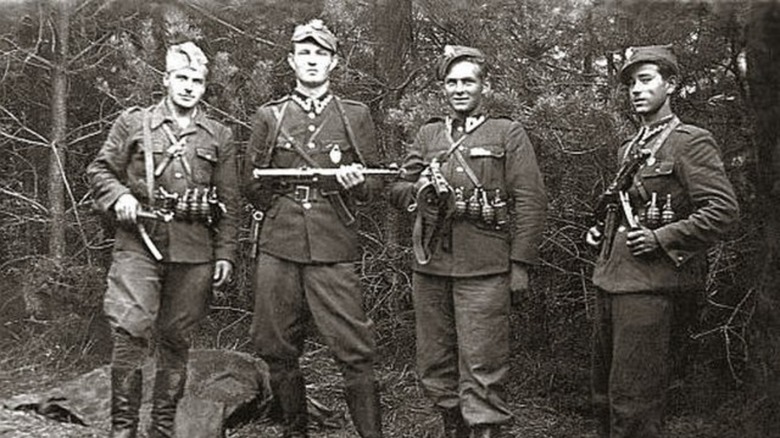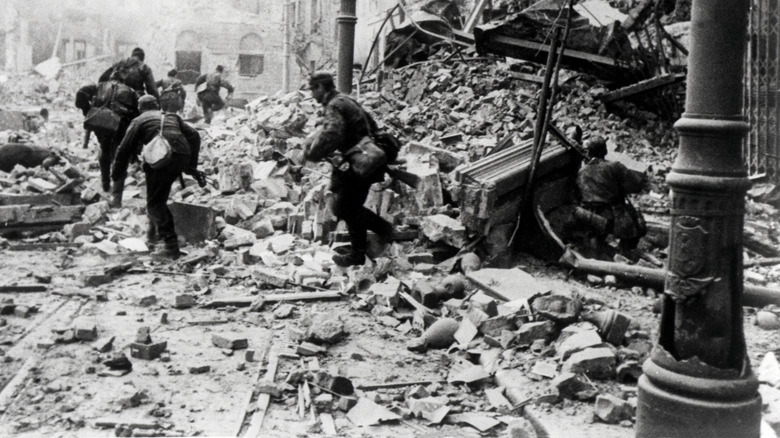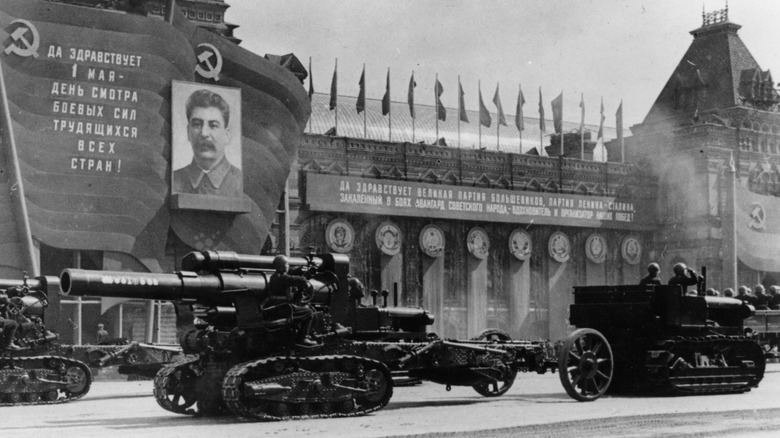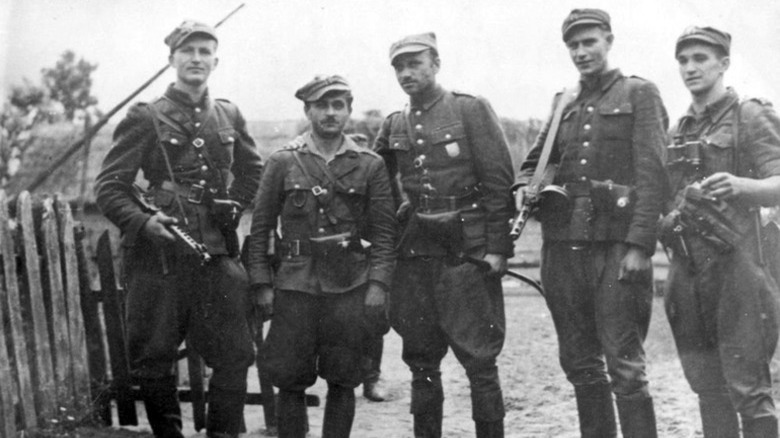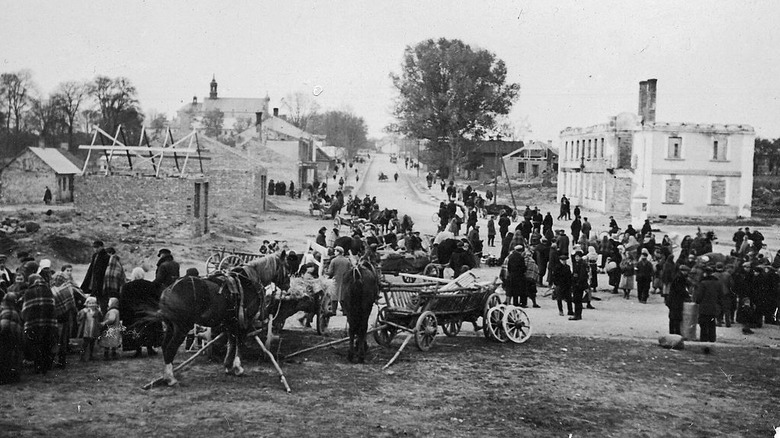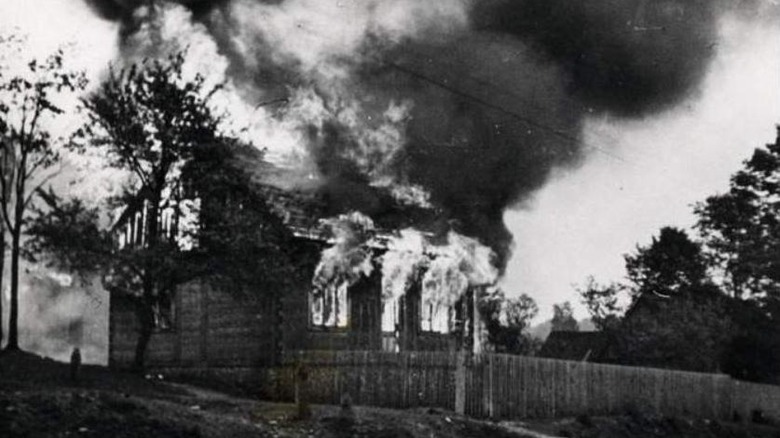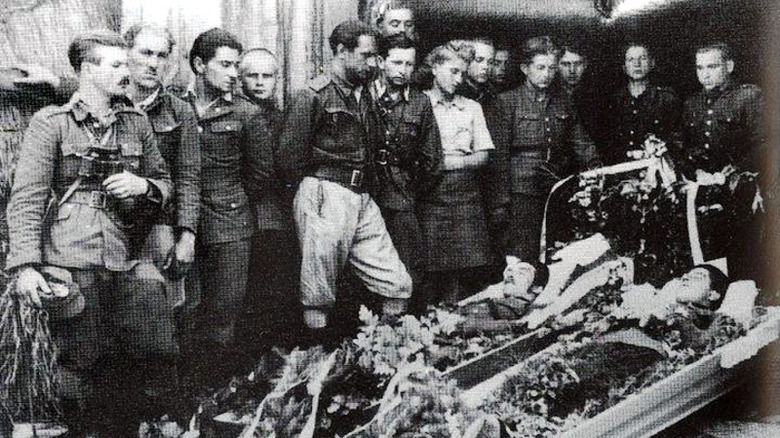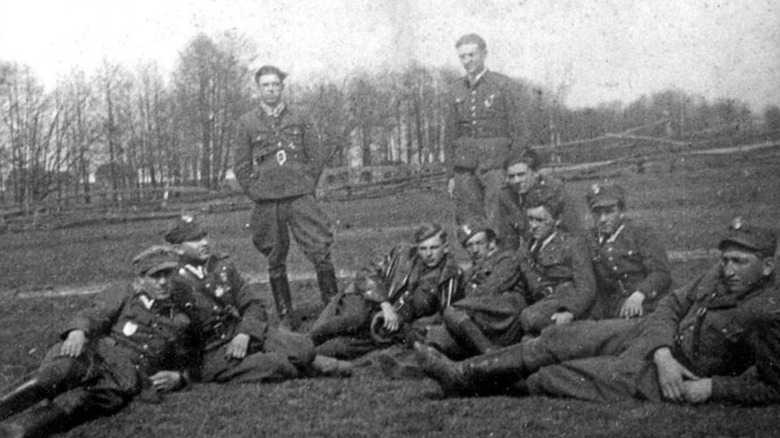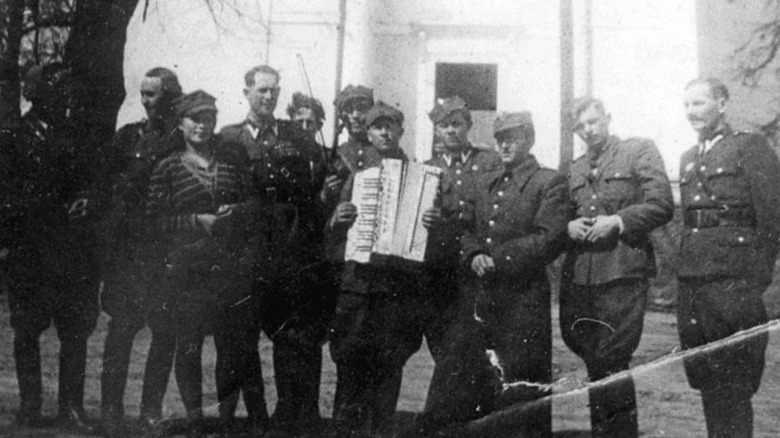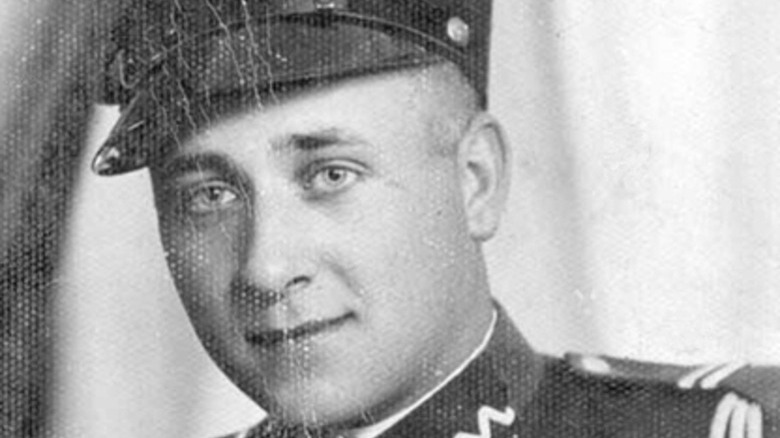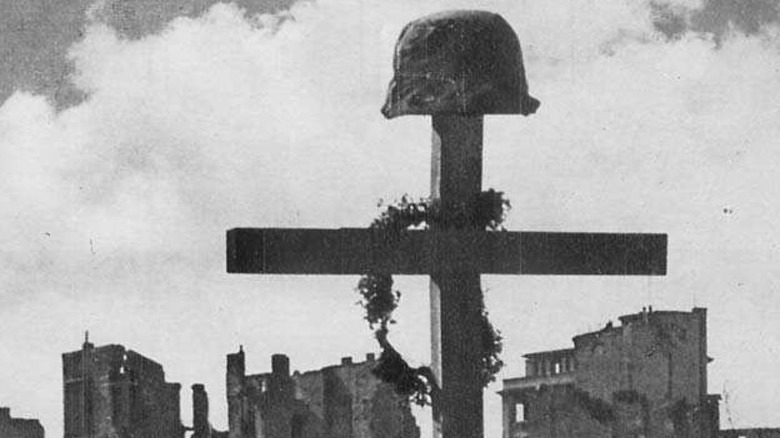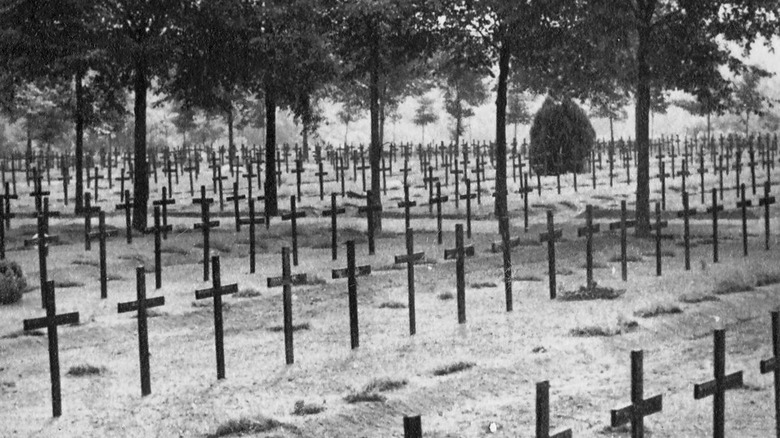Who Were The Cursed Soldiers Of Poland?
History, like human life, hides many hardships. Poland's mass resistance against communism remains obscured by the destruction of historical records. Yet, the origins of the Cursed Soldiers reveal a unique glimpse into the limitations of human suffering and the power of perseverance and resistance in the face of persecution. To understand them, we must first examine the harsh conditions that bore them.
In the wake of World War II, Poland and its people were decimated by the horrors of war, and death and destruction littered the landscape. Since the beginning of the conflict, the country had found itself in the center of a chessboard, caught between two warring ideologies intent on vanquishing one another (per Holocaust Encyclopedia). On their western frontier, the German army threatened the Polish way of life, with Adolf Hitler at its helm. By September 1939, the Polish military fell to the German invaders, and Hitler ordered a ruthless repression of the rural Polish class in an effort to eradicate their shared identity. This was heinously executed to create a despondent and docile peasant class, destined only to serve Germany.
Families were shattered, and countless victims were sent to concentration camps or forced to work for the very war machine that had upended their lives (via Holocaust Encyclopedia). Polish forces were quickly overwhelmed by Joseph Stalin's Red Army on its eastern frontier, and the two warlords carved up the country. In a similarly warped fashion, Stalin believed Poland could be bent to his will and controlled as a communist puppet state (per Holocaust Encyclopedia).
The Warsaw Uprising and the roots of resistance
Despite being outgunned and outflanked, an extensive underground Polish resistance network fought in the shadows for five years to destabilize their oppressors (per Warsaw Institute). As a result, the distinction between resistance fighters and regular citizens became muddied with the Polish Underground. The Warsaw Uprising, however, would irreversibly blur these lines in 1944, as ordinary Poles became forced onto the frontlines.
Operation Barbarossa, a German gamble to sweep through Poland and seize Russia in 1941, backfired spectacularly, via Britannica. The Germans were on the retreat by 1944, with the Red Army pushing them back to Berlin. According to the Holocaust Encyclopedia, many in the Polish Home Army (Armia Krajowa, or AK) feared a full-fledged Soviet takeover, so they began Operation Tempest to expel the Germans. On July 31, 1944, the Polish Home Army launched an armed insurrection in Warsaw. The uprising's primary goals were to free the nation first from the German occupiers, restore Polish sovereignty, and portray Poland as an equal of the Soviet Union (per the National WW2 Museum).
The AK had staked their plans on the Soviet Union's willingness to help them oust the Germans. However, Joseph Stalin wanted to weaken Poland's potential resistance force and ordered his soldiers to hold back in the city's liberation, leaving many civilians to become cannon fodder (via National WW2 Museum). After two months of continuous battle, piles of bodies, and a shell-shocked population, the AK eventually surrendered on October 2, 1944. The Past reports that the Germans would consequently destroy the city and retreat, leaving the door wide open for the Red Army to claim the ruins.
The spread of Stalinism
Joseph Stalin spared little time establishing a Soviet puppet state from the scorched Polish capital. According to Polish History, the NKVD, the Soviet secret police, was dispatched to infiltrate and incapacitate the Polish Underground. Using intelligence obtained by partisans with communist sympathies, the NKVD targeted leaders and civilian collaborators of the Polish Underground movement (per Warsaw Institute). As a result, some estimates suggest somewhere between 50,000 and 60,000 civilians were forced into Soviet labor camps.
The Polish Home Army disbanded on January 19, 1945, but the Soviets were unconvinced. The following month, the Yalta Conference occurred, and the destiny of Poland was once again auctioned off by the war's victors, with Winston Churchill and Franklin D. Roosevelt conceding control of Poland to Stalin, per History. By March, the Provisional Administration of National Unity became the face of Soviet-controlled Poland. Still, many resistance leaders became disillusioned with this new government. In response, they were cordially invited to a "conference," only to be imprisoned, tortured, and shipped off to stand trial in Moscow. First News reports that, to add insult to injury, several of these commanders were humiliated at their June 1945 show trials and accused of collusion with the Nazis, whom they had fought and bled to expel from Poland. On the grand chessboard, Stalin was winning.
Yet, surviving Polish partisans were outraged by Stalin's plan to establish a new Polish state in his image and his purges of troops who helped the Red Army push the Nazis out of Poland. These actions sowed the seeds of resistance and paved the way for the Cursed Soldiers to rise up.
Birth of the Cursed Soldiers
Years of unremitting conflict had fatigued the remaining Polish Underground and their civilian sympathizers. However, these soldiers had little choice when it came to their survival. After bands of troops were tracked down and slain, many partisans took up arms using leftover WWII supplies and weaponry. Since Home Army soldiers were being rounded up and eliminated en masse in newly Soviet-controlled cities and towns, many members retreated into the forests to evade arrest and torture and to bring the fight to the Soviets (per the Warsaw Institute). According to Polish History, at their peak, the estimated number of partisans was 20,000.
Given that the Red Army and Stalinist sympathizers vastly outnumbered these soldiers, these groups are today remembered as the żołnierze wyklęci — the "cursed" or "doomed" soldiers. Due to their legendary resilience and defiance in the face of an insurmountable enemy, they are also known as the "żołnierze niezłomni," or the "indomitable" soldiers (via the Institute of National Remembrance). These partisans formed an effective clandestine network that served as a thorn in the Soviets' side by fighting to stymie the Sovietization of Poland.
Between 1944 and 1947, these rebels conducted a series of "hit-and-run" strikes against Soviet forces and the secret police. Their primary strategy was to kill key Soviet commanders or informers or to release captured brethren from NKVD torture cells and smuggle them out of the country (per Kafkadesk). They would surprise Soviet military installations or Red Army garrisons before disappearing into the sanctuary of the forest. But many lives were lost in these brazen assaults, and by 1947 they had taken a severe toll on the partisans' numbers, according to Polish History.
The hidden resistance
With such a vastly outnumbered fighting force, the only way the Cursed Soldiers could take the fight to the mighty Hammer and Sickle was with the help of everyday allies. Although the number of fighting partisans peaked at 20,000, the actual network of civilian supporters for the Cursed Soldiers might have numbered up to 250,000 (per Polish History). However, we may never know the true figure because many Poles temporarily assisted the Polish Underground.
These unsung heroes of the protective network, like their WWII counterparts, put their lives on the line to aid, support, and conceal the Cursed Soldiers (via Kafkadesk). Furthermore, they greatly supported their cause by supplying critical intelligence to the partisans, allowing them to keep one step ahead of their mutual enemy.
The enmity and terror of living under Joseph Stalin's iron fist — and vengeance for sending countless civilians to forced labor camps — brought these two factions together. However, as eyewitness testimonies from the Doomed Soldiers archives demonstrate, the rural peasant class's hidden sympathizers bore the brunt of Soviet-sponsored violence and retaliation. As in other Eastern European anti-communist battles, Soviet soldiers frequently reacted severely to any involvement with the partisans, murdering their civilian allies or burning entire villages to the ground. But by 1947, the Soviets had realized that these brutal penalties only strengthened the bond between the partisans and civilians (via the National WW2 Museum).
Battle of Kuryłówka
The Battle of Kuryłówka is an armed conflict that perfectly illustrates how the Cursed Soldiers and Soviet troops clashed — and the devastating repercussions that followed. In early May 1945, one of the most resilient anti-communist resistance factions, the National Military Alliance (NZW), assembled 200 partisans in the southern village of Kuryłówka. Meanwhile, two squads of the Soviet NKVD had amassed nearby, looking for a group of deserters who had left the Stalinist forces to join the rebels (via the Institute of National Remembrance).
On May 7, 1945, 200 partisans and 300 NKVD personnel engaged in a fierce seven-hour gunfight. However, the NKVD was forced to cut tail and run due to machine-gun suppression. Researchers estimate that 57 NKVD members were slain. In the aftermath, the insurgents fled, anticipating that the NKVD would return in droves to execute them. Unfortunately, the events of the next day confirmed these fears (per Kafkadesk). On May 8, the NKVD returned to Kuryłówka, armed to the teeth and enraged. In retaliation for the previous day's defeat, they executed several civilians and set the settlement ablaze, torching countless homes and displacing 1,000 villagers.
According to the Institute of National Remembrance, another NKVD unit raided a neighboring village, Przymiarki, on the same day and killed seven people. Since the Battle of Kuryłówka remained hushed for decades, we will never know how many people perished on both sides, or the full extent of the atrocities committed in its shadow.
The Augustów roundup
For the Cursed Soldiers, the Augustów roundup was unquestionably one of their worst defeats. Today, historians recognize it as one of the Soviet Union's most heinous post-war atrocities. Augustów is a thickly forested district in northeastern Poland, bordering Belarus and Lithuania. In the spring of 1945, the communists were fully aware that this territory was not under their dominion. To combat this, Joseph Stalin personally ordered the Augustów roundup to sever support networks between the local populace and partisans (via Polish History).
On July 12, around 45,000 troops (including the First Belarus Front) started sweeping the area. They spent a week scouring the woodlands and villages of the Augustów area, hunting partisans and their sympathizers. Roadblocks and checkpoints were installed, and strict curfews were imposed between 9 p.m. and 8 a.m., making escape practically impossible. In addition, the Soviets meticulously combed the neighboring villages and woodlands, leaving no stone unturned, according to Warsaw Institute.
Many, from children to the elderly, young men to pregnant women, were rounded up and questioned in improvised prisons. Eyewitness accounts collected by the Doomed Soldiers archive describe heavy-handed interrogations accompanied by beatings and torture. Many of the besieged partisans preferred to fight to the death rather than surrender, understanding the grizzly fates that met their compatriots in other regions. Over 7,000 individuals were detained, with hundreds more disappearing into thin air (via Warsaw Institute). Many were driven to the Belarusian border, where they disappeared. We may never know the precise number of people who vanished. It took decades for investigators to determine that 600 to 800 people perished; however, some grim estimates place the death toll as high as 1,500 (via Polish History).
A false white flag
The Cursed Soldiers, while suffering a crushing loss at the Augustów roundup, would not give up, and they fought the Soviet occupation in a series of smaller skirmishes throughout the following year. However, after a national election in 1947 failed to give a glimmer of hope for Polish independence through peaceful political tactics, many partisans felt fatigued by years of fighting (per Polish History).
In February 1947, the Soviet powers that be, however, inflicted irrevocable damage to the Cursed Soldiers' support networks when they offered amnesty to any resistance fighters who laid down their arms. Astonishingly, approximately 55,000 combatants and collaborators from many anti-communist militias came forward, hoping to find a modicum of peace (via ”Twilight Warriors”). Many people who came out of hiding to quell the bloodshed found themselves promptly detained, deported, tortured, and even executed (per Gazeta Ciechanów).
Through self-preservation or coercion, many people tipped off the secret police about the few remaining resistance members. The Soviets punished even the peasant class. According to Gazeta Ciechanów, feeding or housing the hidden partisans, even for a single night, could land a person in prison for five to eight years; others were executed for storing firearms or documents. Polish HIstory reports that after the 1947 amnesty ended, only about 1,000 armed anti-communists remained in the shadows in small, isolated units. By becoming so fragmented, the remaining Cursed Soldiers were too easy for the Soviet forces to pick off one by one.
[Featured image by archive photos of polish historical institution - IPN via Wikimedia Commons | Cropped and scaled | CC BY-SA 4.0
Final throes of the Cursed Soldiers
With the treachery of the 1947 "amnesty," the Cursed Soldiers' fate was sealed. Communist authorities substantially reduced their numbers by methodical eradication, and by 1949, only isolated groups remained. Over time, the priority of these organizations evolved from preventing Soviet takeover to sheer survival and dodging state-sponsored killing squads. Many lone partisans would have to watch over their shoulders for the rest of their lives. As a result, many took on new identities to evade suspicion (per Polish History). But what were the consequences if one fell into the clutches of the Soviets?
In most cases, being caught meant certain death. Countless people were dragged into custody, tortured, starved, convicted, and executed by firing squad or hangings (per The First News). In the Soviets' campaign to stifle dissent and gain intel, both troops and hapless citizens were tortured into betraying their allies. The harrowing first-hand testimonials of survivors demonstrate that many innocent individuals suffered terribly at the hands of their fellow countrymen in the secret police (via Doomed Soldiers archive).
While many historians dedicated to preserving the legacy of the Cursed Soldiers agree that 1947 marks the bitter end for the partisans, others argue that the constitution of 1952, which gave Poland a new name — the Polish People's Republic (per IPN) — was the true Soviet propaganda victory, as it indicated that communism was there to stay, writes Polish History. As a result, Poland remained communist until the Soviet Union's disintegration in 1991.
[Featured image by archive photos of polish historical institution - IPN via Wikimedia Commons | Cropped and scaled | CC BY-SA 4.0
The last Cursed Soldier
In the eyes of many, the demise of the last Cursed Soldier, Józef Franczak, in 1963 marks the group's symbolic ending. His journey with the Cursed Soldiers is riveting, with multiple nail-biting moments of arrest and escape before slipping into obscurity.
Franczak, or "Lalek," was a soldier of Polish independence partisan groups in Lublin. Like many of his contemporaries, he participated in anti-security strikes and assassinated informants (per Przystanek Historia). While the new regime eliminated the final partisans, Franczak spent the last decade of his life looking over his shoulder, surviving thanks to a network of sympathizers. Despite the harsh repercussions of hiding him, Franczak often sought sanctuary in the countryside with ordinary people.
In 1963, the secret police eventually tracked Franczak down after an informant infiltrated Franczak's network of supporters, who did not detect the deceit. On October 21, 1963, the farmstead where Franczak was hiding became encircled by 37 state police. "Lalek" opened fire on the communists, prompting a barrage of machine-gun fire in retaliation (per Przystanek Historia). Franczak refused to surrender and was mortally wounded in the ensuing shootout. At the time of his death, the last Polish partisan was 45 years old. He had eluded law enforcement for 18 years before his last stand, outliving Joseph Stalin by a decade (via Historia Polski). Franczak's status as a folk hero has been cemented throughout the years by a succession of tributes. Today, a monument of Franczak stands in Piaski, and he was featured on a national postal stamp in 2022 (via Institute of National Remembrance).
Consequences of the conflict
In the end, the sheer number of troops and seemingly infinite resources of the Soviets proved too much for the earnest Cursed Soldiers. Upon their defeat, many attempts were made to erase their resistance from the annals of history. As such, many of the true figures regarding fatalities remain shrouded in mystery. All that's left are estimates.
Regardless of the outcome, the armed conflict between the communists and the Polish partisans resulted in a tremendous loss of life on both sides. Unfortunately, the true total is unknown since many captured partisans were executed without trials or whisked away. According to some estimates, 8,000 partisans were killed in direct battle, 5,000 were executed, and another 21,000 were transported off to die in prisons or labor camps (via Polish History). On the Soviet side, the estimated death toll is also high. According to Kafkadesk, some surmise that 23,000 communist troops (including 1,000 NKVD agents) were killed by the partisans.
Legacy today
Despite the temptation to paint the plight of the Cursed Soldiers as a valiant David vs. Goliath scenario, the legacy of these anti-communist rebels remains controversial.
Since the Soviets sought to banish the Cursed Soldiers from history, many sources have been lost. There is still much to learn about them. In all battles, innocent bystanders are often caught in the crossfire, and this conflict was no exception. A classic Soviet tactic to divide their foes in Eastern Europe was to increase partisan paranoia, frequently leading to many civilians being murdered as suspected informants (per the National WW2 Museum). Due to these brutal reprisals and war crimes committed by some Cursed Soldiers against innocent citizens in Lithuania and Belarus, certain efforts to commemorate the Cursed Soldiers have courted controversy, as reported by Notes from Poland.
Nonetheless, these partisans continue to have a positive image in Poland. According to the Republic of Poland, March 1 has been declared a public holiday to honor them since 2011. Many historians are intent on keeping their struggles for a free Poland alive. Others regard resistance to a regime with zero qualms about terrorizing and murdering its rural classes as heroic. But the actual scope of their suffering remains hidden in plain sight, as new victims are continually discovered in unmarked graves, per The First News. Even today, many relatives of the "disappeared" continue to seek answers concerning their loved one's fate.
